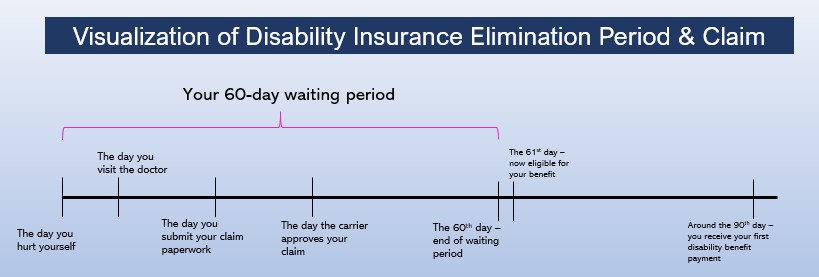Short-term disability insurance is a valuable resource designed to provide financial protection when you are unable to work due to a disability, illness, or injury. However, it’s important to grasp the concept of the elimination period when considering a short-term disability policy. In this blog, we will explore the short-term disability elimination period, its significance, and other essential factors to consider when securing this valuable coverage.
What is the Short-Term Disability Elimination Period?
The elimination period, also known as the waiting period, is a specific period of time that you must wait after a disabling event occurs before your short-term disability insurance benefits become payable. It is essentially a deductible of time rather than a monetary amount. During this period, you are responsible for covering your expenses, including medical bills and daily living costs, until your insurance benefits kick in.
Key Points to Understand About the Short-Term Disability Elimination Period:
Varied Lengths: Elimination periods for short-term disability policies can range from a few days to a few weeks, with 7, 14, and 30 days being common choices. The length of the elimination period you select will influence your policy’s premium.
Customizable: One of the benefits of short-term disability insurance is that you can typically customize your policy by choosing the elimination period that aligns with your financial situation and risk tolerance. Shorter elimination periods result in higher premiums, while longer periods lead to lower premiums.
No Retroactive Payments:
Short-term disability benefits usually do not cover the elimination period retroactively. This means that your benefits will begin after the elimination period ends, and you won’t receive compensation for that period.
Influences Waiting Time:
The elimination period significantly impacts when you will start receiving disability benefits. A shorter elimination period ensures quicker access to benefits, which can be crucial if you need immediate financial support during a disability.
Assess Your Financial Situation: When choosing your elimination period, consider your current financial situation. If you have an emergency fund or savings that can cover expenses during a short elimination period, you may opt for a shorter waiting time. Conversely, a longer elimination period might be suitable if you want to reduce your premium costs.
Workplace Policies: If you have disability coverage through your employer, you should be aware of your employer’s policy regarding the elimination period. Workplace policies may have pre-determined waiting periods that you should be familiar with.
Overlap with Sick Leave: For employees, the elimination period may overlap with available sick leave. Some employers allow employees to use accrued sick days during the elimination period, which can provide a financial cushion before disability benefits commence.
Documentation and Application: When applying for short-term disability benefits, it’s essential to provide accurate and thorough documentation to support your claim. Insurance providers may require medical records and other evidence of your disability.
Additional Factors to Consider When Purchasing Short-Term Disability Insurance:
Benefit Amount: Determine the amount of coverage you need to replace your income during a short-term disability. Most policies provide benefits equal to a percentage of your regular income.
Duration of Coverage: Short-term disability policies offer coverage for a limited duration, typically ranging from a few weeks to a few months. Evaluate your needs and responsibilities to choose an appropriate benefit period.
Policy Exclusions: Review your policy to understand any exclusions or conditions that may impact your eligibility for benefits. It’s crucial to know what is and isn’t covered.
Premium Costs: Short-term disability insurance premiums can vary based on factors such as the benefit amount, elimination period, and your age and occupation. Compare different policies to find the best balance between coverage and cost.
Final Words
Understanding the short-term disability elimination period is vital when purchasing this type of coverage. The elimination period determines how long you must wait before you start receiving benefits. It’s a customizable aspect of your policy, allowing you to align it with your financial situation and preferences. Careful consideration of the elimination period, along with other policy features, is essential to ensure you have the right short-term disability insurance to protect your financial security during times of disability.


